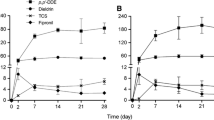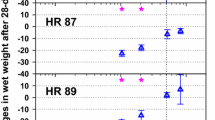Abstract
The bioavailability of retene spiked to two sediment concentrations (50 and 200 µg/g dry weight) was measured in long-term (28-day) bioaccumulation tests performed on the oligochaeteLumbriculus variegatus Müller. Three sediment organic carbon (SOC) concentrations (1.1, 3.0, 23.0% of dry weight) were used. Growth and reproduction, used as endpoints, indicated that retene was chronically nontoxic at the concentrations employed. Retene was clearly bioavailable, but bioaccumulated about 100 times less in the SOC-rich (23.0%) sediment than in the other two (SOC <3.0%). At the lower retene concentration, retene in the worms was undetectable in the high-SOC sediment. Based on final retene present at the end of exposure, the bioaccumulation factors (BAFs) ranged between 1.1–28.2. Normalization to organism lipid and SOC content diminished the variation, so that the biota-sediment accumulation factors (BSAFs) varied from 0.8 to 13.5. When calculated from initial retene concentrations, BAFs within the range of 0.04 to 5.3 and BSAFs from 0.1 to 2.5 were obtained. Results demonstrate that high levels of SOC diminish the bioavailability of sediment-associated retene inL. variegatus considerably. However, the remainder variation in the BSAFs suggests that besides of SOC and worm lipid contents there are also other factors that can affect the bioaccumulation dynamics of sediment-associated retene and the final outcome of its bioavailability.
Similar content being viewed by others
References
American Society for Testing and Materials (1995): Standard guide for measuring the toxicity of sediment-associated contaminants with freshwater invertebrates. E1706-95a. In: Annual Book of ASTM Standards, Vol. 11.05. Philadelphia, Pa, p 1138–1220
American Society for Testing and Materials (1977): Standard guide for determination of the bioaccumulation of sediment-associated contaminants by benthic invertebrates. E1688-97a. In: Annual Book of ASTM Standards, Vol 11.05. Philadelphia, Pa, p 1072–1121
Billiard SM, Querbach K, Hodson PV (1999): Toxicity of retene to early life stages of two freshwater fish species. Environ Toxicol Chem18, 2070–2077
Brunson EL, Canfield TJ, Dwyer FJ, Ingersoli CG, Kemble NE (1998): Assessing the bioaccumulation of contaminants from sediments of the upper Mississippi River using field-collected Oligochaetes and laboratory-exposedLumbriculus variegatus. Arch Environ Contam Toxicol35, 191–201
Burnison BK, Hodson PV, Nuttley DJ, Efler S (1996): A bleachedkraft mill effluent fraction causing induction of a fish mixed-function oxygenase enzyme. Environ Toxicol Chem15, 1524–1531
Chapman PM (2000): Aquatic Oligochaetes are useful for (but underutilized in) ecological risk assessment (ERA). Society of Environmental Toxicology and Chemistry, SETAC Globe1, 31–33
Chen W, Gongmin ATK, Vignona LC, Tomson MB (1999): Adsorptiondesorption behaviors of hydrophobic organic compounds in sediments of Lake Charles, Louisiana, USA. Environ Toxicol Chem18, 1610–1616
Fragoso NM, Parrott JL, Hahn ME, Hodson PV (1998): Chronic retene exposure causes sustained induction of CYP1A activity and protein in rainbow trout(Oncorhynchus mykiss). Environ Toxicol Chem17, 2347–2353
Fragoso NM, Hodson PV, Kozin IS, Brown RS, Parrott JL (1999): Kinetics of mixed function oxygenase induction and retene excretion in retene-exposed rainbow trout(Oncorhynchus mykiss). Environ Toxicol Chem18, 2268–2274
Garcia KL, Delfino JJ, Powell DH (1993): Nonregulated organic compound in Florida sediments. Wat Res27, 1601–1613
Helfrich J, Armstrong DE (1986): Polycyclic aromatic hydrocarbons in sediments of the southern basin of Lake Michigan. J Great Lakes Res12, 192–199
ISO ({dy1996}): Water Quality. Determination of the Inhibition of the Mobility ofDaphnia magna Straus (Cladocera, Crustacea). Acute Toxicity Test. International Standard, 6341, 1996 (E), p 1–9
ISO/CD ({dy1994}): Water Quality. Determination of the inhibitory effect of water samples on the light emission ofVibrio fisceri (Luminescent bacteria test). International Standard, 11348, 1994-09, p 1–31
Kraaij R, Ciarclli S, Tolls J, Kater BJ, Belfroid A. (2001): Bio-availability of lab-contaminated and native polycyclic aromatic hydrocarbons to the amphipodCorophium volutator relates to chemical desorption. Environ Toxicol Chem20, 1716–1724
Krotz L, Ragaglia L, Andreolini F (1995): Rapid elemental analysis in sediments, vegetal material and participate matter in water. Poster presented at Mediterranean Chem. International Conference on Chemistry and the Mediterranean Sea. Taranto, Italy, May 23–27
Kukkonen JVK, Landrum PF (1994): Toxicokinetics and toxicity of sediment-associated pyrene toLumbriculus variegatus (Oligochaete). Environ Toxicol Chem13, 1457–1468
Kukkonen JVK, Landrum PF (1995): Effects of sediment-bound polydirnethylsiloxane on the bioavailability and distribution of benzo(a)pyrene in lake sediment toLumbriculus variegatus. Environ Toxicol Chem14, 523–531
Kukkonen JVK, Landrum PF (1998): Effect of particle-xenobiotic contact time on bioavailability of sediment-associated benzo(a)- pyrene to benthic amphipod,Diporeia spp. Aquat Toxicol42, 229–242
Landrum PF (1989): Bioavailability and toxicokinetics of polycyclic aromatic hydrocarbons sorbed to sediment for the AmphipodPontoporeia hoyi. Environ Sci Technol23, 588–595
Leppänen H, Oikari A (1999): Occurrence of retene and resin acids in sediments and fish bile from a lake receiving pulp and paper mill effluents. Environ Toxicol Chem18, 1498–1505
Leppänen H, Kukkonen JVK, Oikari AOJ (2000): Concentration of retene and resin acids in sedimenting particles collected from a bleached kraft mill effluent receiving lake. Wat Res34, 1604–1610
Leppänen H, Oikari A (2001): Retene and resin acid concentrations in sediment profiles of a lake recovering from exposure to pulp mill effluents. J Paleolimnology3, 367–374
Leppänen MT, Kukkonen JVK (1998): Relationship between reproduction, sediment type, and feeding activity ofLumbriculus variegatus (Müller): implications for sediment toxicity testing. Environ Toxicol Chem17, 2196–2202
Leppänen M, Kukkonen JVK (2000): Fate of sediment-associated pyrene and benzo[a]pyrene in the freshwater oligochaeteLumbriculus variegatus (Müller). Aquat Toxicol49, 199–212
Ma W-C, Immerzeel J, Bodt J (1995): Earthworm and food interactions on bioaccumulation and disappearance in soil of polycyclic aromatic hydrocarbons: studies on phenanthrene and fluoranthene. Ecotoxicol Environ Saf32, 226–232
Mackay D, Shiu WY, Ma KC (1992): Polycyclic aromatic hydrocarbons, polychlorinated dioxins, and dibenzofurans. In: Illustrated Handbook of Physical-Chemical Properties and Environmental Fate for Organic Chemicals (D. Mackay, WY. Shiu, KC. Ma, Eds.), Vol. II, p 163–171, 209–216. Lewis, Boca Raton, FL
Masclet P, Hoyau V, Jaffrezo JL, Legrand M (1995): Evidence for the presence of polycyclic aromatic hydrocarbons in the polar atmosphere and in the polar ice of Greenland. Analusis23, 250–252
Mount DR, Dawson TD, Burkhard LP (1999): Implications of gut purging for tissue residues determined in bioaccumulation testing of sediment withLumbriculus variegatus. Environ Toxicol Chem18, 1244–1249
Nieuwenhuize J, Maas YEM, Middelburg JJ (1994): Rapid analysis of organic carbon and nitrogen in paniculate materials. Marine Chemistry45, 217–224
Phipps GL, Ankley GT, Benoit DA, Mattson VR (1993): Use of the aquatic OligochaeteLumbriculus variegatus for assessing the toxicity and bioaccumulation of sediment-associated contaminants. Environ Toxicol Chem12, 269–279
Ramdahl T (1983): Retene — a molecular marker of wood combustion in ambient air. Nature306, 580–582
Tavendale MH, Wilkins AL, Langdon AG, Mackie KL, Stuthridge TR, McFarlane PN (1995): Analytical methodology for the determination of freely available bleached kraft mill effluent-derived organic constituents in recipient sediments. Environ Sci Technol29, 1407–1414
Tracey GA, Hansen DJ (1996): Use of biota-sediment accumulation factors to assess similarity of nonionic organic chemical exposure to benthically-coupled organisms of differing trophic mode. Arch Environ Contam Toxicol30, 467–475
Van Hoof PL, Kukkonen JVK, Landrum PF (2001): Impact of sediment manipulation on the bioaccumulation of polycyclic aromatic hydrocarbons from field-contaminated and laboratory- dosed sediments by an oligochaete. Environ Toxicol Chem20 (8), (in press)
Wakeham SG (1996): Aliphatic and polycyclic aromatic hydrocarbons in Black Sea sediments. Mar Chem53, 187–205
White JC, Hunter M, Nam K, Pignatello JJ, Alexander M (1999a): Correlation between biological and physical availabilities of phenanthrene in soils and soil humin in aging experiments. Environ Toxicol Chem18, 1720–1727
White JC, Hunter M, Nam K, Pignatello JJ, Alexander M (1999b): Increase in bioavailability of aged phenanthrene in soils by competitive displacement with pyrene. Environ Toxicol Chem18, 1728–1732
Author information
Authors and Affiliations
Corresponding author
Rights and permissions
About this article
Cite this article
Nikkilä, A., Kukkonen, J.V.K. & Oikari, A. Sediment-associated retene bioavailability of sediment-associated retene to an oligochaete wormlumbriculus variegatus . J Soils & Sediments 1, 137–145 (2001). https://doi.org/10.1007/BF02986476
Received:
Accepted:
Issue Date:
DOI: https://doi.org/10.1007/BF02986476




